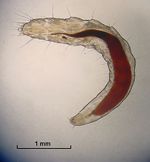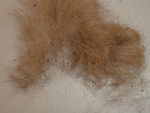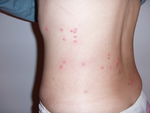Fleas
Jump to navigation
Jump to search
| This article has been peer reviewed but is awaiting expert review. If you would like to help with this, please see more information about expert reviewing. |
Flea Life Cycle
A thorough understanding of the flea life-cycle is important in order to be able to advise owners of adequate treatments to control flea infections on their animals and within the home environment.
- The time for the egg to develop into the adult flea takes 3-4 weeks in summer
- Duration of the life cycle is dependent on environmental temperature
1. Adults
- Uses changes in light intensity, warmth and carbon dioxide to locate host
- Once on host, the flea will usually remain
- With animals in close contact there may be a small degree of transfer between hosts
- The majority of adult fleas are acquired from the environment
- The adult flea takes frequent blood meals. 97% of fleas will feed within 1 hour of finding a host and feed for about 10-25 minutes.
- Flea dirt (faeces) are produced in large quantities
- The life span of the flea is determined by the grooming activity of the host
- Usually the adult flea lives for between 7 and 10 days
2. Eggs
- The adult lays eggs 1-2 days after locating a host
- Approximately 15 eggs are layed in the coat per day
- Eggs are ivory white, oval and approxiamtely 0.5mm long
- The eggs drop to the ground within hours
- In reality this usually happens when the animal jumps of the sofa or makes sudden movements. Flea eggs will therefore cluster in these hot spots around the house. These areas should be paid particular attention when treating the environment in the case of a flea infestation.
3. Larvae
- Larvae are small, about 2-5mm in length
- Larvae are yellow/white (look like maggots) and are covered in bristles
- They have chitinous mouthparts and anal struts which can be used for identification
- Larvae are negatively phototropic so try to move away from light sources
- E.g. under furniture, into thick mats or carpet
- Larvae feed on skin debris from other animals, flea dirt and other organic debris
- High humidity is needed for survival
- Freezing temperatures will kill larvae
4. Pupae
- The larvae pupate forming pupae of 5mm in length
- A silken cocoon surrounds the pupae
- Slightly sticky so small particles adhere to it
- These quickly become camouflaged in the environment
- Methoprene, the juvenile development hormone coordinates the growth of the immature stages
- Activates genetic switches
- Determines the sequence of tissue and organ development
- Newly developed adults do not leave the cocoon straight away
- The pupal window is the time that it takes for the adult to emerge
- Temperature determines when the adult fleas emerge
- Some fleas may wait several months before emerging
- Newly emerged unfed adults can survive days without feeding but once they have fed, if they fall off the host they can only survive hours
Habitats
- Only approximately 5% of the flea population will be on the animal at any one time (and usually it is a much smaller percentage)
- The rest of the population are in the environment
- E.g. Eggs, larvae, pupae and unfed adults
- Fleas accumulate in certain hot spots where the animal spends the majority of its time
- E.g. Warm, shady, humid ares
- E.g. Outdoors in warmer climates or inside in temperate climates
- Very large numbers of eggs are found in areas where cats land after jumping as they have been dislodged
- E.g. Beside sofas
Control
- Single or occasional treatments will only give temporary relief from fleas as the majority of the population is in the environment
- Appropriate action must be taken to stop re-infestation
- The animal must be rid of its resident flea population
- The animal should be protected against subsequent re-infestation
- From within the home
- From outside the home
- The environmental reservoir population should be eliminated
- Animal treatment to deplete reservoir
- Adulticides
- Adulticides with larvicidal effects
- Insect growth regulators (IGR's)
- Direct chemical treatment of domestic environment
- Insecticides
- Insect growth regulators
- Inorganic chemicals
- Entomophagous nematodes (These are parasitic nematodes which predate other parasite eggs)
- Animal treatment to deplete reservoir
- To prevent resistance occurring, control methods should not rely solely on chemical methods
- Hygiene such as regular vacuuming and washing of the animal's bedding should also occur for the most effective treatment
- For more information on the chemicals used for flea treatment click here
Species of veterinary importance
Other important flea species
- Fleas of wildlife can sometimes infect domestic animals
Fleas Flashcards
Links
Internal
- Fleas act as intermediate hosts for Dipylidium tapeworms
- Fleas act as vectors for myxomatosis in rabbits
External


